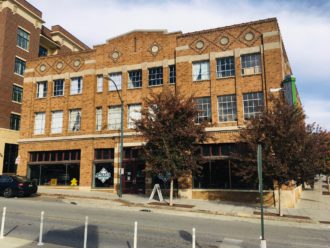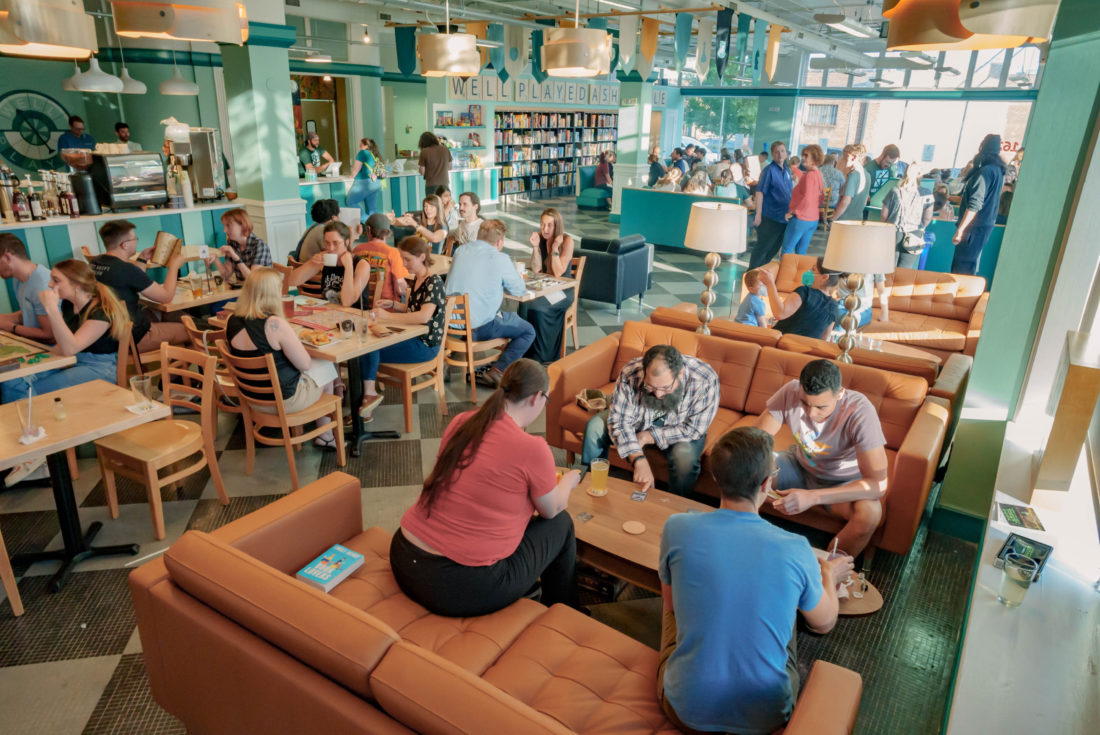Plenty of structures in Asheville have housed various businesses over the years, but if the walls of the Conabeer Motor Building could talk, they’d share some of the city’s most diverse tales.
However, with steady foot traffic to and from neighboring breweries and restaurants in the popular South Slope area, plus the 500-unit Ironwood mixed-use complex on Asheland Avenue currently under construction, odds are most locals and tourists alike walk by the building unaware of its storied past.
“I think in a city like Asheville, with so many historic buildings that have been preserved and reused for various purposes over the years, it’s always a positive thing to examine and share the history of a space,” says Katherine Calhoun Cutshall, collection manager for Buncombe County Special Collections. “Knowing the story of a structure brings it life and character that can encourage folks to continue to care for the building for years to come.”
Floor models
Built in 1928 and designed by the architectural firm of Beacham and LeGrand, the three-story space at 162-164 Coxe Ave. has been home to Well Played Board Game Café since the summer. But true to its name, it was originally the site of a car dealership — part of the city’s first “motor mile” that included numerous automotive businesses. The street’s namesake, the Coxe family, developed the property and leased it to the Conabeer Motor Co., a local Chrysler dealership whose tenure eventually changed the site’s name to the Conabeer Chrysler Building.
Well Played owner Kevan Frazier, who’s also an urban historian, sees evidence of that initial purpose in the ground-floor space, now designated as Suite 101. Of particular interest is the floor itself, composed of a checkered square pattern with each shape containing hundreds of smaller individual squares.
“This was the showroom, thus the beautiful tile floor — which for a board game café, we were like, ‘Hell yeah!’” he says.
Like the floor, the tall glass windows that increased the former cars’ visibility to passersby remain intact, and the curved walls behind Well Played’s main counter are also original.
“From what we understand, they brought the cars in from the back to set in the display. There’s no sign that the front doors were wide enough,” Frazier says. “The second floor was parts, and the third floor was storage for the cars.”
Though Frazier notes that multiple buildings in town had car elevators — 192 Coxe Ave. still has an operational one — the Chrysler Building used a ramp system to move cars from floor to floor. But in the 1950s and ’60s, the nationwide trend of suburbanization had moved many residents and businesses outside Asheville and coincided with car dealerships needing more land and moving out of downtown showrooms.
New identities
By 1953, Charlotte-based shirt manufacturing firm Kar-Lyn took over the space, opening a garment plant at 162-164 Coxe Ave. that employed 100 people. As late as 1958, it shared the building in some capacity with local dealer Dorato Motors, but in November 1974, with the shirt company gone, furniture store Factory Sales & Surplus took over the lease and occupied it until closing in February 1999.
Various charity organizations then had a presence in the building. The Asheville Citizen Times reports that Asheville Buncombe Community Christian Ministry hosted its Sharing Affair Auction there in July 2000, followed by the Asheville Jaycees sponsoring a holiday charity auction in November 2001. And a December 2003 article mentions the space as the headquarters of the Asheville Optimist Club’s Santa Pal project, which provided toys to families in need.
In February 2001, developer George Morosani announced that work should begin in the next couple of months to turn the structure into an office building with a parking deck next door. Though he anticipated the project’s completion by the end of the year, it wasn’t until six years later when developer Alexander Reagan LLC made that plan a reality.
“Historic buildings are inherently sustainable because they reuse something that is already built, while at the same time preserving the architectural soul of the community,” Jack Shrode, director of construction for the company, told the Citizen Times in May 2007.
Beer to board games
The Conabeer Chrysler Building was listed on the National Register of Historic Places in 1979. Frazier notes that the U.S. Department of the Interior, which awards such distinctions, primarily protects the exterior of buildings. In turn, he says, 162-164 Coxe’s zoning within the central business district allows for a fair amount of interior changes. Upon moving in, Frazier found a floor plan for tall-walled cubicles that were installed, as well as other evidence of modernization during the building’s office era.
“We have lots of weird electrical that doesn’t make sense,” Frazier says. “We have all these boxes that have nothing attached to them. We found an old hole where they had run the power down on a column. I don’t know if it distributed to the cubicle’s cubes or not, but all of it got pulled out.”
When Tasty Beverage Co. leased the space in 2014, just as the South Slope beer district was coming into its own, Johnny Belflower moved his business into an open room. The bottle shop and taproom’s pilot location in Raleigh is likewise in a century-old building — a former freight depot — and while Belflower feels that historic spaces have a lot of charm and beauty, being a tenant can come with headaches and limitations.
“To increase our maximum occupancy [at 162-164 Coxe], the doors — which had always swung into the building — needed to swing out, but because of the historic designation, that required a special exemption,” Belflower says. “And while all that natural light is wonderful, single-pane glass isn’t the most efficient for that many windows, so electricity bills were fairly costly.”
Other than repainting and adding its own logos, the Well Played team didn’t change much after Tasty vacated the space in fall 2020 due to the COVID-19 pandemic. Frazier says he and his colleagues did some reconfiguration of the bar to increase space, turned the small dish pit where Tasty cleaned glasses into a kitchen and, in what required the most work, converted what had been an employee break room into the dish room.
Far less effort was required to find space for Well Played’s game collection. Tasty had housed its coolers on the far wall that runs parallel to Coxe, and in that vacated space, the shelving that houses the games slid in remarkably well.
“It fits within 8 inches,” Frazier says. “We have a little 4-inch gap on each side. We were like, ‘This is meant to be.’”

Preservation games
Since 2012, the building has been owned by Mark Maynard of Wilmington-based Tribute Properties. His son Matt Maynard, co-executive managing director of investment and development, only had two requests for Well Played: Don’t destroy the columns and keep the floor as intact as possible.
“This floor has had very little major damage to it. You’ll see a missing tile here or there, but even the way we’ve got the bar in, if the next folks pull it, the most they’re going to have are a few broken tiles from some screws or things,” Frazier says. “We designed on purpose not to put in a floor drain or anything like that. This floor has made it almost 100 years, and I’m not going to be the guy who keeps it from getting to 100.”
Frazier adds that, based on the cornice molding and row of windows atop the main large plates of glass, the space’s ceiling would have initially been open and wouldn’t have had exposed pipes, which provide sewer and HVAC services for the condos that are currently on the second and third floors.
The mix of new and old works well for Frazier, despite such quirks as the thick original walls that he says, “beat our Wi-Fi to pieces.” Considering the breadth of history that’s passed through the space, he feels it indicates Asheville’s changing nature and thinks it’s healthy that so many different businesses have called the building home.
“I appreciate in cities when you do see that sort of evolution,” Frazier says. “I think part of the reason why when the Department of Interior standards were created, the compromise was about the focus on the outside rather than the inside. The insides are going to change in buildings, but to be able to preserve that architectural style outside is more important.”




Before you comment
The comments section is here to provide a platform for civil dialogue on the issues we face together as a local community. Xpress is committed to offering this platform for all voices, but when the tone of the discussion gets nasty or strays off topic, we believe many people choose not to participate. Xpress editors are determined to moderate comments to ensure a constructive interchange is maintained. All comments judged not to be in keeping with the spirit of civil discourse will be removed and repeat violators will be banned. See here for our terms of service. Thank you for being part of this effort to promote respectful discussion.